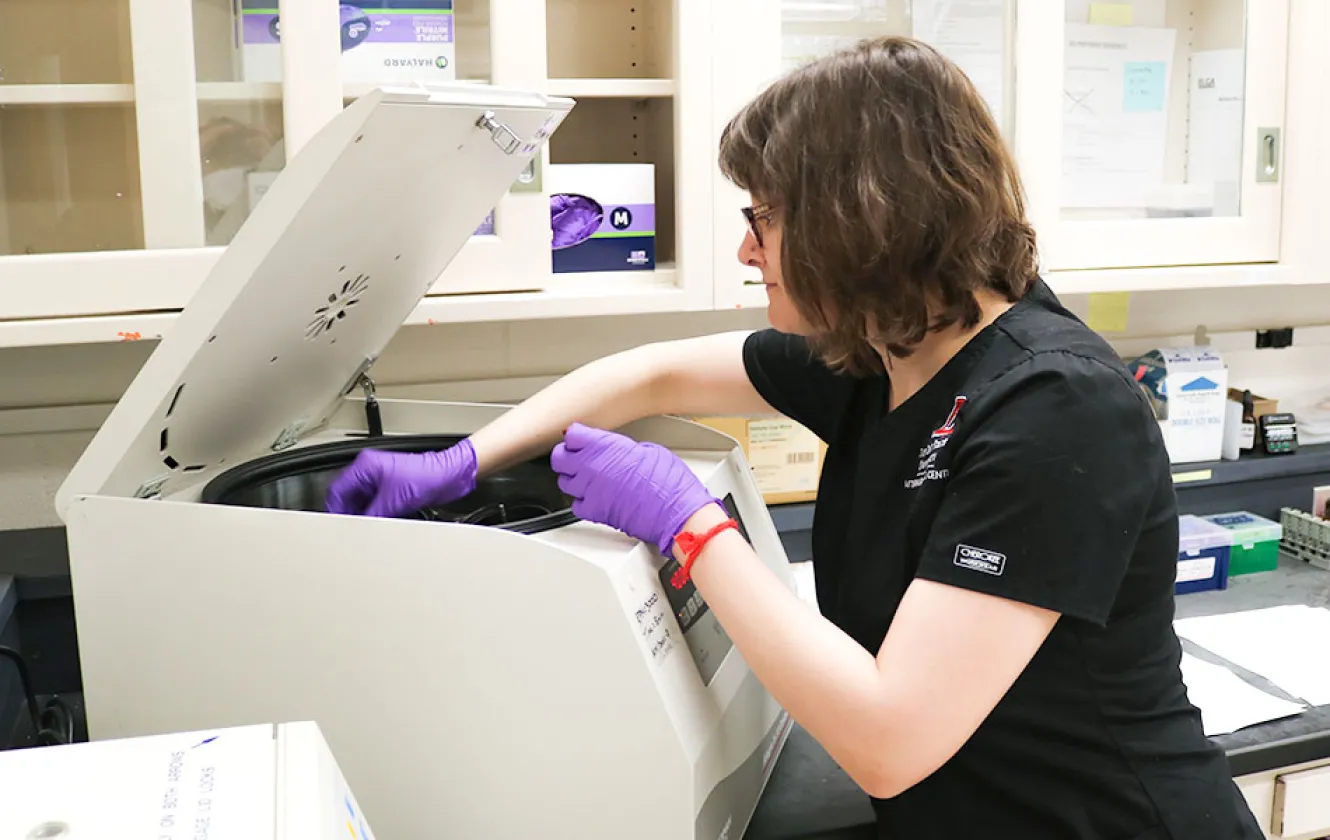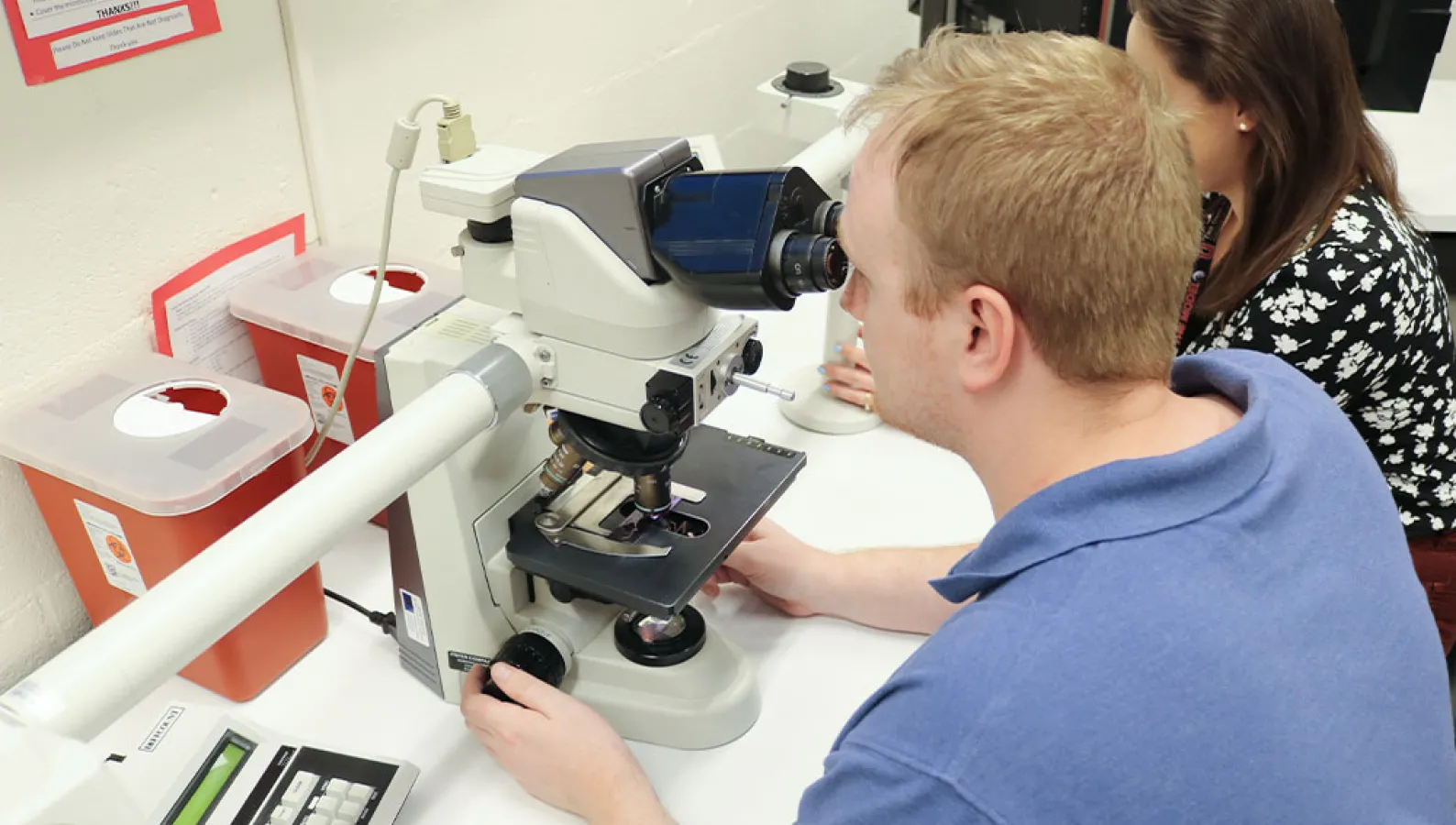Research Opportunities
The success of our combined training program is the breadth of research opportunities. The Ohio State University (OSU) College of Veterinary Medicine (CVM) is a vital component of one of the most comprehensive health sciences centers in America, which includes seven Health Science Colleges on a single campus. As such, students have access to an unparalleled diversity of research mentors in multiple colleges, many of which are part of the Comprehensive Cancer Center, the Infectious Diseases Institute, and the Ohio State Neurological Institute.
Approaches span basic to translational, with focus areas including drug discovery, vaccine development, medical devices, microbiome science, bioinformatics, and image analysis, to name but a few.

-
Research
- Access to hundreds of research programs within seven health science colleges and other institutes, including:
- Wexner Medical Center
- James Comprehensive Cancer Center
- Infectious Disease Institute
- Nationwide Children’s Hospital
- College of Veterinary Medicine
- Access to hundreds of research programs within seven health science colleges and other institutes, including:
-
Pathology
- Anatomic Pathology: Diverse caseload serving the OSU Veterinary Medical Center, regional practitioners, the Columbus Zoo and Wilds, and Columbus Humane
- Clinical Pathology: Robust caseload serving the OSU Veterinary Medical Center, as well as Digital Cytology service and the Veterinary Clinical Flow Cytometry service
-
Success
- 100% Phase I (36/36) and 96% Phase II (23/24) ACVP Exam Pass Rate (since 2016)
- Trainees have been awarded:
- T32/F32 fellowships
- NIH Loan Repayment Program
- Industry fellowships
- Numerous intramural scholarships and awards
-
Careers
- Our graduates are leaders in their respective career sectors.
- Graduates are currently employed in:
- Pharma/Biotech (>50%)
- Academia (~25%)
- Diagnostic laboratories and others
Program Progression and Training
Trainees spend their first year in the Combined Program primarily focused on diagnostic training while exploring and identifying their PhD research advisors/laboratories. Second year and beyond, trainees devote the majority of their time towards PhD dissertation work, developing in their basic research knowledge base, technical skills, writing, and scientific approaches. Diagnostic service is greatly reduced, with training supplemented with regularly scheduled pathology seminars and rounds, journal clubs, coursework and additional opportunities that keep pace with new developments in our approach to pathology. This system has proved highly effective in developing both diagnostic and research skills that define the pathologist-scientist.

Sub Programs
As part of the most comprehensive health sciences center in America, the Department of Veterinary Biosciences in the College of Veterinary Medicine at The Ohio State University offers outstanding training opportunities for students whose career goals include specialty education in veterinary anatomic pathology and graduate education in Comparative Biomedical Sciences leading to a PhD. The objective of the anatomic pathology residency is to provide trainees with experience in the autopsy, surgical pathology and clinical pathology laboratories. Research training for anatomic pathology residents is designed to provide experience with molecular biology, virology, oncology, biochemistry, immunohistochemistry, gnotobiology, cell culture, and quantitative histomorphometry in investigation of the pathogenesis of disease.
Facilities
Pathology training utilizes laboratories at Ohio State University which support autopsy, surgical pathology, and clinical pathology services for the large caseload in the Veterinary Medical Center, regional practitioners, the Columbus Zoo, the Capital Area Humane Society, and the University Comparative Pathology & Mouse Phenotyping Shared Resource which provides diagnostic pathology support to the University Laboratory Animal Resources and investigators utilizing animal models of disease with an emphasis on genetically modified mice. Characterization of genetically-modified mice is supported by an NIH training grant and draws upon submissions to the Phenotyping Shared Resource. Trainees also interact with Ohio Department of Agriculture pathologists. Research opportunities for PhD training are diverse, ranging from the study of infectious disease to oncology and drug discovery, and include basic, comparative, and translational work both within the college and with funded collaborative partners throughout the OSU health sciences community and Nationwide Children’s Hospital.
Tuition & Stipend
- Stipends begin at $35,004
- A $1,000 bonus is applied toward the cost of educational supplies
- Tuition is provided ($14,910/resident or $41,750/non-resident per year)
- The university pays 85% (approximately $2819/year) of the cost of student health insurance
Applications for position(s) to begin the program in the summer are due the proceeding October.
Application Checklist
- DVM from an AVMA-accredited institution is preferred
- Curriculum Vitae
- Statement of career goals
- Three letters of reference
- Copies of GRE scores (if available) and academic transcripts (undergrad and DVM/VMD) with class rank
- English proficiency minimum requirements for International students from non-English speaking countries
Upon acceptance into the Combined Anatomic Pathology Residency/PhD Program, applicants will then be asked to complete an OSU Graduate School Application and a background check.
As part of the most comprehensive health sciences center in America, the Department of Veterinary Biosciences in the College of Veterinary Medicine at The Ohio State University offers outstanding training opportunities for students whose career goals include specialty education in veterinary clinical pathology and graduate education in Comparative Biomedical Sciences leading to a PhD. With dual credentials, our graduates are highly competitive for careers in academia, industry, diagnostic laboratories, and government.
The objective of the clinical pathology program is to provide training in clinical chemistry, cytology, hematology, immunology, surgical pathology and molecular techniques. Trainees are directly involved in the teaching and diagnostic services of the clinical pathology laboratories. Research training for clinical pathology residents is designed to provide experience with molecular biology, transgenic animal pathobiology, virology, oncology, biochemistry, immunohistochemistry, gnotobiology, cell culture, and quantitative histomorphometry in investigation of the pathogenesis of disease.
Facilities
Clinical pathology training utilizes laboratories at The Ohio State University that support the large caseload of the Veterinary Medical Center as well as classroom and individualized training directed by boarded pathologists. Additional training and resources are provided by the surgical pathology and autopsy services, the University Comparative Pathology & Mouse Phenotyping Shared Resource, and the Clinical Immunophenotyping Service. Large and small class didactic, laboratory, and small group teaching opportunities are an integral part of the program and provide trainees hands-on experience with different teaching models.
Research opportunities for PhD training are diverse, ranging from the study of infectious disease to oncology and drug discovery, and include basic, comparative, and translational work both within the college and with funded collaborative partners throughout the OSU health sciences community and Nationwide Children’s Hospital.
Tuition & Stipend
- Stipends begin at $37,135.
- $1,000 of funds to use for travel/educational purposes
- Tuition is provided
- The university pays 100% of st student health insurance
Applications for position(s) to begin the program in the summer are due the proceeding October.
Application Checklist
- DVM from an AVMA-accredited institution
- Curriculum Vitae that includes research and clinical pathology experience
- Statement of career goals
- Three letters of reference
- Copies of GRE scores (if available) and academic transcripts (undergrad and DVM/VMD) with class rank
- English proficiency minimum requirements for International students from non-English speaking countries
Upon acceptance into the Combined Clinical Pathology Residency/Graduate Program, applicants will then be asked to complete an OSU Graduate School Application and a background check.
Current Trainees
Anatomic Pathology Trainees
| Max Waugh | Brittney Graham | Aaron Dunkerson |
| PI: Christy Petersen |
Clinical Pathology Trainees
| Kari Frankhouse |
Anatomic Pathology Trainees
| Anna Foley | Andrew McGlynn |
| PI: Dr. Purnima Dubey | PI: Dr. Vanessa Hale & Dr. Gregory Ballash |
Clinical Pathology Trainees
| Danielle Ahmed |
| PI: Dr. Christy Petersen |
Anatomic Pathology Trainees
| Bayla Bessemer | Kate Sarkan |
| PI: Dr. Rolf Stottman | PI: Dr. Jessica Quimby |
Clinical Pathology Trainees
| Basant Ahmed |
| PI: Dr. Gordon Meares |
Anatomic Pathology Trainees
| Allysa Cole | Sophie Hopkins |
| PI: Dr. John Gunn | PI: Dr. Eugene Oltz |
Clinical Pathology Trainees
| Sam Neal |
| PI: Dr. Kara Corps |
Anatomic Pathology Trainees
| Emily King | Janice Park |
| PI: Dr. Amanda Panfil | PI: Dr. Andy Bowman |
Clinical Pathology Trainees
| Ally Bonney | Sam Sommer |
| PI: Dr. Laura Pomeroy | PI: Dr. Dean Lee |
Externships
The Ohio State University College of Veterinary Medicine offers two-week externships in anatomic or clinical pathology for fourth year DVM students. During the externship, students participate in pathology services and seminars, and are provided the opportunity to explore the university research environment. The externship is an excellent opportunity for those considering an application to the Combined Pathology/PhD Program – a firsthand look at how the program works and the community of faculty students/trainees and staff. Externships are scheduled individually and those interested are strongly encouraged to reach out at least 6 months in advance.
If you are interested in applying for an externship with Ohio State, please contact CVM-OSUVETPathGrad@osu.edu for more information.
Learn more about the program & apply
Combined Pathology/PhD Program position openings are posted on the ACVP.org site under “training opportunities”. A call for applications to the Combined Pathology/PhD Training Program will typically be posted beginning in June, with applications reviewed as received (deadline, October 15th).
Training Program Directors
Mike Oglesbee, DVM, PhD, Diplomate ACVP
oglesbee.1@osu.edu
Ryan Jennings, DVM, PhD, Diplomate ACVP
jennings.398@osu.edu
Education Program Coordinator
Emily Bode
CVM-OSUVETPathGrad@osu.edu

















